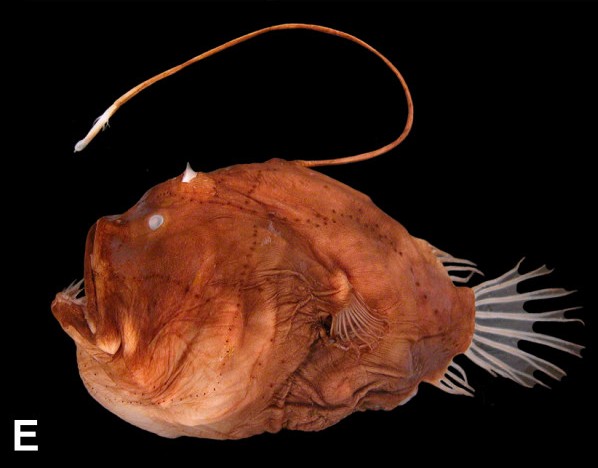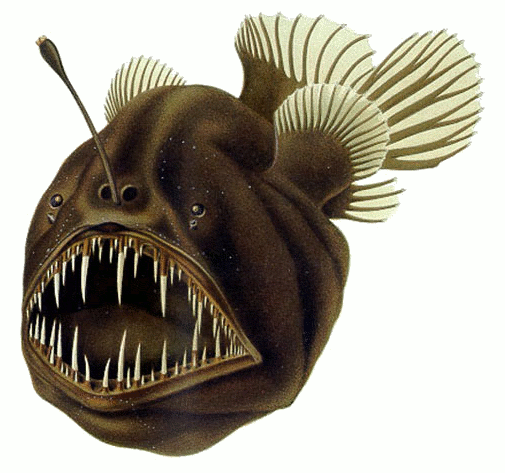Difference Between Esca and Illicium
The key difference between esca and illicium is that esca is a fleshy growth found at the end of the illicium while illicium is a movable stalk or rod developed as a result of modification of the first spine of anglerfish.
Anglerfish is a bony fish which is popular for its unique mode of predation. Its first spine has been modified into a movable fishing pole with a little bait in the end. The fishing pole is known as illicium while the bait is known as esca. Esca is a fleshy growth. It acts as a lure for other fishes. When other predatory fishes notice the esca and swim near it by thinking it is a suitable prey, anglerfish eats it before it gets a chance to swallow the esca.
CONTENTS
1. Overview and Key Difference
2. What is Esca
3. What is Illicium
4. Similarities Between Esca and Illicium
5. Side by Side Comparison – Esca vs Illicium in Tabular Form
6. Summary
What is Esca?
Esca is a fleshy growth located at the end of the illicium. It is a little bait which acts as a lure for other predatory fishes. Anglerfish uses this esca in order to catch its prey. When other predatory fishes see it and try to swallow esca, anglerfish catch them before they get a chance to swallow the esca.

Figure 01: Anglerfish
However, if the esca is not visible for other fishes, their predatory mechanism does not work. Therefore, most of the anglerfishes living in deep-sea maintain a symbiotic relationship with certain types of bacteria which produce light. These bacteria colonize the esca and make it glow in the dark. Since the body of the anglerfish does not emit light, the fish can stay hidden while the esca glows in the water. The shape of the esca may differ among the species. Sometimes, lure or esca mimics a small animal such as a warm, shrimp or small fish, etc.
What is Illicium?
In anglerfish, the first dorsal spine is modified into a fishing pole or a movable fishing rod. This fishing pole is known as illicium or luring apparatus. It has a fleshy lure or esca at the end.

Figure 02: Illustration of Humpback Anglerfish
The illicium is attached to the first or spinous dorsal fin and extends over the eyes of the fish. The length of illicium varies among the different species. In some anglerfish species, illicium is striped. Illicium brings the pray closer to anglerfish.
What are the Similarities Between Esca and Illicium?
- Esca and illicium are two structures that are used in predatory mechanisms of anglerfish.
- Esca is the fleshy part located at the end of the illicium.
- These structures help to identify anglerfish.
What is the Difference Between Esca and Illicium?
Esca is the fleshy growth situated at the end of the illicium while illicium is the modified dorsal fin spine of anglerfish which is a fishing rod. So, this is the key difference between esca and illicium. Besides, esca acts as a lure and attracts prey for anglerfish while illicium brings pray closer to anglerfish.
Moreover, esca can have different shapes like small animals, while illicium is a stalk.
Below infographic summarizes the difference between esca and illicium.

Summary – Esca vs Illicium
Anglerfish has an unusual predatory technique. The first dorsal fin spin is modified into a fishing pole with a tip acting as a lure. The whole structure is important for anglerfish for predation. The fishing pole is known as illicium while the fleshy end growth is known as esca. Illicium and esca are unique structures to anglerfish, and these structures aid in the identification of anglerfish. Thus, this summarizes the difference between esca and illicium.
Reference:
1. “Anglerfish”. Aquaticcommunity.Com, 2020, Available here.
2. “Frogfish / Anglerfish (Antennariidae): Characteristics – Frogfish Terms – Esca And Illicium – Tips For The Identification Of Frogfishes. With Illustrations And Photos”. Frogfish.Ch, 2020, Available here.
Image Courtesy:
1. “Bufoceratias” By Masaki Miya et al. – Evolutionary history of anglerfishes (Teleostei: Lophiiformes): a mitogenomic perspective. BMC Evolutionary Biology 2010, 10:58 doi:10.1186/1471-2148-10-58 (CC BY 2.0) via Commons Wikimedia
2. “Humpback anglerfish” (Public Domain) via Commons Wikimedia
ncG1vNJzZmivp6x7pbXFn5yrnZ6YsqOx07CcnqZemLyue8OinZ%2Bdopq7pLGMm5ytr5Wau26x0pyYZpmemXqquMuimqKtnWQ%3D